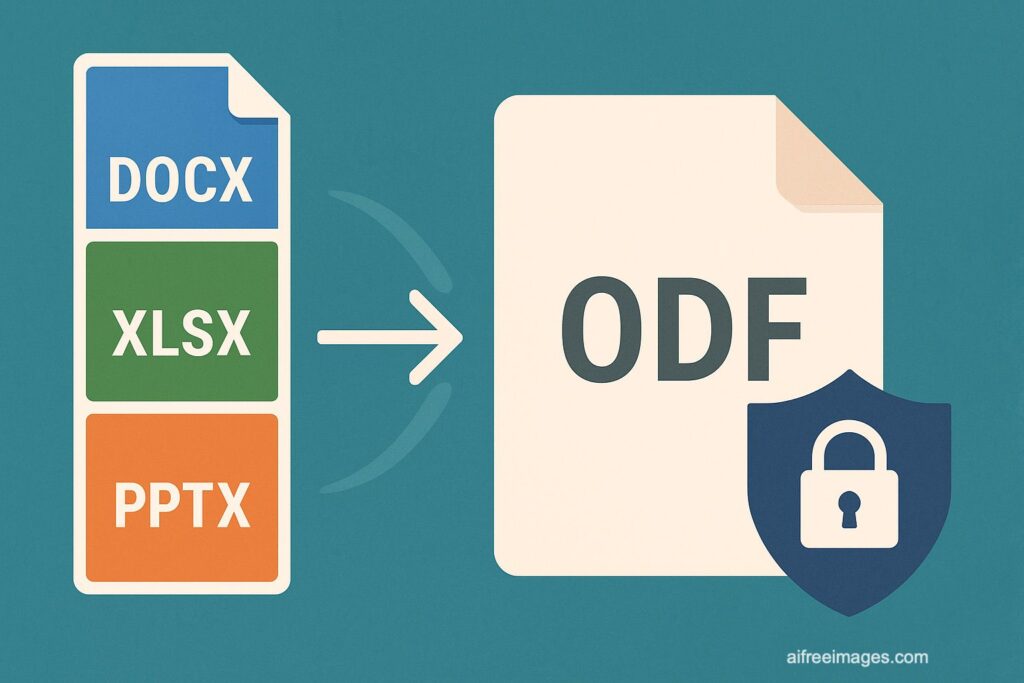In the field of system administration, document management is a critical element. Although formats such as DOCX, XLSX, and PPTX remain ubiquitous, their proprietary nature poses a risk of vendor lock-in and an increasing cost in licenses and compatibility. In contrast, the Open Document Format (ODF), ISO/IEC 26300 standard, stands out as an open, interoperable, and sustainable alternative.
The Document Foundation, the organization behind LibreOffice, recently published a migration guide that highlights the keys to making the switch. This article expands on that guidance with a practical and technical approach, aimed at IT teams who need to plan, execute, and maintain a large-scale migration to ODF in complex organizations.
1. Initial Audit: Document Inventory
A migration project must begin with a comprehensive inventory:
- Classification by file type: DOC, DOCX, XLS, XLSX, PPT, PPTX.
- Total volume: number of documents and how many are considered active.
- Complexity: macros, advanced templates, ERP/CRM integrations, or embedded multimedia.
- Prioritization: differentiate between critical documents and those that can be archived or discarded.
📌 Tip: batch analysis tools such as find, file, or exiftool can help identify extensions and metadata across large network repositories.
2. Migration Strategy: Gradual vs. Total
In corporate environments, it is crucial to define a clear approach:
- Gradual migration: convert only active, day-to-day documents and keep legacy files as read-only.
- Total migration: bulk conversion of the entire document repository.
Typically, the best approach is to run a pilot project with one department, validating compatibility before rolling out the transition organization-wide.
3. Bulk Conversion Tools
There are several options to automate document conversion to ODF:
- LibreOffice in headless mode
libreoffice --headless --convert-to odt *.docxlibreoffice --headless --convert-to ods *.xlsxlibreoffice --headless --convert-to odp *.pptx
This allows batch processing of entire folders from bash or PowerShell scripts. - Unoconv
Based on the LibreOffice API, supports more flexible conversions and integrates with Linux and Windows environments. - PyODConverter or UNO API macros
Suitable for customized integrations in document conversion pipelines. - Nextcloud + Collabora Online / OnlyOffice (ODF mode)
Organizations with collaborative cloud platforms can configure them so that all documents are automatically saved in ODF.
4. Conversion Validation
After conversion, it is critical to perform quality checks:
- Format and design: ensure that styles, tables, and graphics are preserved.
- Spreadsheet formulas: verify compatibility in environments with complex calculations.
- Macros: probably the most critical point. VBA macros are not 100% compatible; in many cases, they must be rewritten in LibreOffice Basic or via Python UNO.
📌 Practical advice: use comparison tools such as diff-pdf or automated screenshot captures of documents before and after migration to validate conversion batches.
5. Environment Configuration and Policies
Once documents are migrated, the next step is to enforce ODF as the corporate standard:
- Configure LibreOffice (or another compatible suite) to ODF as default format under Tools > Options > Load/Save > General.
- In Windows Active Directory, deploy Group Policy Objects (GPOs) to enforce ODF as default format across all users.
- In collaborative platforms (Nextcloud, OwnCloud, SharePoint with plugins), integrate automatic converters to ODF.
6. Training and Support
Resistance to change is often the biggest obstacle. To mitigate it:
- Short, practical training sessions: 1–2 hour workshops to explain key differences.
- Internal manuals with screenshots and step-by-step instructions.
- First-line support reinforced during the first weeks after deployment.
7. Technical and Economic Benefits
Once migration is completed, the advantages are clear:
- Guaranteed interoperability: independence from specific vendors.
- Cost savings: suites like LibreOffice are free and can coexist with paid ones in hybrid environments.
- Document longevity: ODF is an ISO standard, ensuring long-term access.
- Regulatory compliance: many governments require the use of open formats for official documents.
8. Common Challenges
- VBA Macros: the biggest hurdle; they require manual adaptation.
- User reluctance: many users prefer to continue working with DOCX/XLSX out of habit.
- Third-party compatibility: some clients or providers will still send proprietary formats.
For these cases, it is advisable to enable bidirectional converters, while maintaining ODF as the internal standard.
9. Success Stories
- European governments such as Spain, France, and Germany have adopted ODF as the official format in public administration.
- Private companies in the banking and education sectors have implemented ODF to cut license costs and increase technological independence.
Conclusion
For a system administrator, migrating to ODF is not just about document compatibility, but a strategic step towards digital sovereignty, cost savings, and long-term security.
The key is rigorous planning: inventory, pilot testing, automated bulk conversion, validation, centralized policy enforcement, and user training. Once the initial hurdles are overcome, the benefits far outweigh the costs.
Frequently Asked Questions (FAQ)
How can I convert thousands of documents at once?
With LibreOffice in headless mode (--convert-to) or tools like Unoconv, integrated into automation scripts.
What happens to Excel/Calc macros?
VBA macros are not fully compatible. They must be rewritten in LibreOffice Basic or Python UNO.
Can I use both DOCX and ODF at the same time?
Yes, but it is recommended to enforce ODF as the internal standard and use automatic converters for external documents.
What is the security impact?
Using an open, standardized format reduces risks of hidden vulnerabilities or dependencies on proprietary software.

